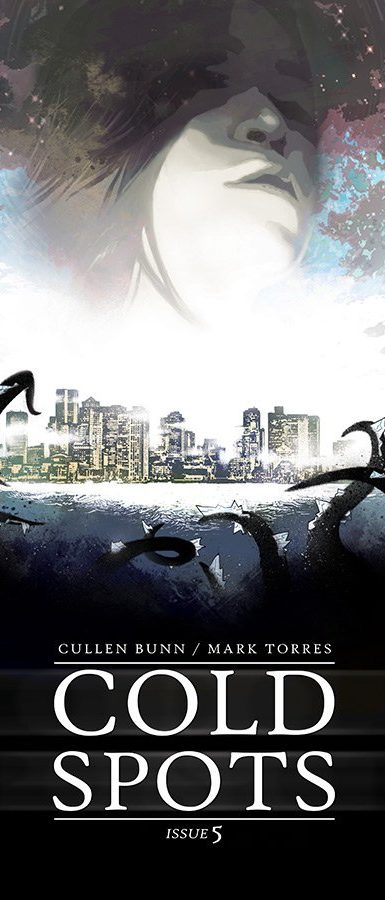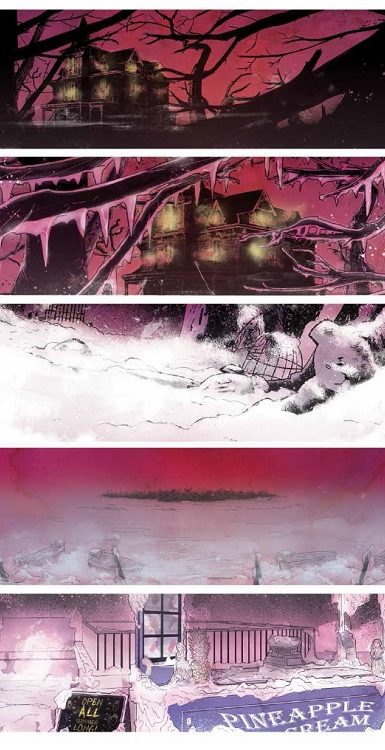The final issue of Cullen Bunn and Mark Torres’ horror comic Cold Spots sends a shiver down your spine while revealing who is really in charge of the supernatural onslaught.
After the first four issues of world building in the Image comics mini-series, where the reader has followed Dan on his journey to find and rescue his daughter, the Evil has finally been released, and the world is inundated with ghosts and spectres. Alyssa and Dan are imprisoned in the eerie house while their daughter Grace is used to awaken demonic forces. There is a twist, however, which becomes apparent during a daring escape attempt and the tragic consequences are felt by all of the central characters.

The previous issues have all been leading to this dramatic ending. Each, in turn, has encapsulated a different element of a horror story; driving with a mystery, through an indulgent ghost story, and on to Satanic worship. This final issue of the run focuses on visual horror but also the character development of the central cast. Bunn brings the situation to a head so that he can force the characters to show their true faces. The cruelty and desperation of Samuel and Henrietta play out as they realize exactly what it is they have unleashed. Alyssa breaks under the guilt of allowing her daughter to be used.
Up to this point, Bunn has slowly paced the narrative, edging the reader into his ghost story but in this issue, the pace picks up. There is a lot of action and the inclusion of so many new elements. Despite this, Bunn manages to keep the narrative easy to follow without being overwhelming. He also manages to introduce a number of shocks which keep you on your toes to the very last page.
The Beast that is raised is brilliantly designed to be both visually horrific but also mentally challenging. It works as an instant physical threat, which Torres illustrates to great effect, but also represents a growing, unstoppable evil that Dan can only run away from. Even at this point when he has finally learned to take responsibility for his life, Bunn places Dan in a situation that is too overwhelming. Dan has to run; he has no choice. As the character grows, he is unfortunately taken further out of his depth.
This aspect of the narrative is an intrinsic part of any good horror. The hero must continually strive to survive, but with each step forward a greater obstacle is faced. Nancy had this problem in the originally Nightmare on Elm Street; Rick faces this during each story arc of The Walking Dead; and Christine couldn’t escape the escalation of terror in Winnebago Graveyard.

Another aspect of any good horror story is its ability to build an atmosphere. Luckily Cold Spots has Torres on Art duties. The combination of watercolor washes and often heavy shadowed characters creates an unsettling aesthetic. The lack of striking panel borders also gives each page the impression that the images are melding into one as if the panels themselves are ghosting, blurring the lines between two worlds.
Torres uses a fairly straightforward layout on each page, with only an occasion overlapping panel or gutter break but the organized chaos within the panels creates the impression that Torres is breaking all of the rules. The artwork unbalances the reader which has the subconscious effect of slowing down the pace. Even in the moments where the characters are running for their lives, the reader is forced to read at an uncomfortably slow pace, allowing the fear to build. In previous issues, this has caused some of the pacing to be slightly off, but in this final issue, it is spot on.
One of the true highlights of this comic has to be the design of the ghosts. Whenever they are on a page, you can almost feel the temperature drop. The barely visible shadows of former people are eerie and disturbing. To see them interact with the world around them is terrifying and much more effective than grotesque monsters and over the top violence. To look into the pure white spots of the ghost’s eyes fills the reader with unnerving dread.

Simon Bowland has a difficult job of keeping the narrative flowing at the correct speed. His lettering adds a sense of importance and urgency to the proceedings. Whether it’s through the use of black speech balloons with white text for the beast or by breaking up blocks of speech into joined but distinct balloons to extend the speaking time, Bowland manages to draw the reader across the page while building the characters. Where Torres creates the atmosphere, Bowland creates the emotional content. The anger and fear all come through the lettering.
Between them, Bunn, Torres, and Bowland have produced an unsettling and surprisingly original horror comic. It has a disturbing surface story with an equally disturbing underbelly. If you enjoy the works of Raw Fawkes or Steve Niles, then Cold Spots is definitely for you. And, if the final word from Bunn proves to be correct, we haven’t seen the last of this disturbing world.

